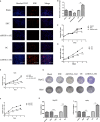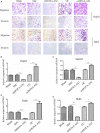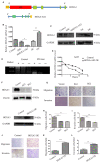ARID1B/SUB1-activated lncRNA HOXA-AS2 drives the malignant behaviour of hepatoblastoma through regulation of HOXA3
- PMID: 33683826
- PMCID: PMC8034473
- DOI: 10.1111/jcmm.16435
ARID1B/SUB1-activated lncRNA HOXA-AS2 drives the malignant behaviour of hepatoblastoma through regulation of HOXA3
Abstract
It has been becoming increasingly evident that long non-coding RNAs (lncRNAs) play important roles in various human cancers. However, the biological processes and clinical significance of most lncRNAs in hepatoblastoma (HB) remain unclear. In our previous study, genome-wide analysis with a lncRNA microarray found that lncRNA HOXA-AS2 was up-regulated in HB. Stable transfected cell lines with HOXA-AS2 knockdown or overexpression were constructed in HepG2 and Huh6 cells, respectively. Our data revealed knockdown of HOXA-AS2 increased cell apoptosis and inhibited cell proliferation, migration and invasion in HB. Up-regulation of HOXA-AS2 promoted HB malignant biological behaviours. Mechanistic investigations indicated that HOXA-AS2 was modulated by chromatin remodelling factor ARID1B and transcription co-activator SUB1, thereby protecting HOXA3 from degradation. Therefore, HOXA-AS2 positively regulates HOXA3, which might partly demonstrate the involvement of HOXA3 in HOXA-AS2-mediated HB carcinogenesis. In conclusion, HOXA-AS2 is significantly overexpressed in HB and the ARID1B/HOXA-AS2/HOXA3 axis plays a critical role in HB tumorigenesis and development. These results might provide a potential new target for HB diagnosis and therapy.
Keywords: chromatin remodelling factor; hepatoblastoma; lncRNA; tumorigenesis.
© 2021 The Authors. Journal of Cellular and Molecular Medicine published by Foundation for Cellular and Molecular Medicine and John Wiley & Sons Ltd.
Conflict of interest statement
The authors declare that they have no conflict of interest.
Consent for publication: All the authors give their consent for publication.
Figures







Similar articles
-
HOX Antisense lincRNA HOXA-AS2 Promotes Tumorigenesis of Hepatocellular Carcinoma.Cell Physiol Biochem. 2016;40(1-2):287-296. doi: 10.1159/000452545. Epub 2016 Nov 18. Cell Physiol Biochem. 2016. PMID: 27855366
-
LncRNA HOXA-AS2 Facilitates Tumorigenesis and Progression of Papillary Thyroid Cancer by Modulating the miR-15a-5p/HOXA3 Axis.Hum Gene Ther. 2019 May;30(5):618-631. doi: 10.1089/hum.2018.109. Epub 2019 Feb 26. Hum Gene Ther. 2019. PMID: 30375256
-
HOXA-AS2 Promotes Proliferation and Induces Epithelial-Mesenchymal Transition via the miR-520c-3p/GPC3 Axis in Hepatocellular Carcinoma.Cell Physiol Biochem. 2018;50(6):2124-2138. doi: 10.1159/000495056. Epub 2018 Nov 9. Cell Physiol Biochem. 2018. PMID: 30415263
-
LncRNA HOXA-AS2 and its molecular mechanisms in human cancer.Clin Chim Acta. 2018 Oct;485:229-233. doi: 10.1016/j.cca.2018.07.004. Epub 2018 Jul 4. Clin Chim Acta. 2018. PMID: 29981289 Review.
-
The functional role of LncRNA HOXA-AS2 in multiple human cancers.Pathol Res Pract. 2025 Feb;266:155795. doi: 10.1016/j.prp.2024.155795. Epub 2024 Dec 24. Pathol Res Pract. 2025. PMID: 39756105 Review.
Cited by
-
LncRNAs and CircRNAs in cancer.MedComm (2020). 2022 May 12;3(2):e141. doi: 10.1002/mco2.141. eCollection 2022 Jun. MedComm (2020). 2022. PMID: 35592755 Free PMC article. Review.
-
Epigenetic targeting of MECOM/KRAS axis by JIB-04 impairs tumorigenesis and cisplatin resistance in MECOM-amplified ovarian cancer.Cell Death Discov. 2025 Jul 15;11(1):326. doi: 10.1038/s41420-025-02618-2. Cell Death Discov. 2025. PMID: 40664642 Free PMC article.
-
Role of HOXA1-4 in the development of genetic and malignant diseases.Biomark Res. 2024 Feb 5;12(1):18. doi: 10.1186/s40364-024-00569-x. Biomark Res. 2024. PMID: 38311789 Free PMC article. Review.
-
The Curious Case of the HepG2 Cell Line: 40 Years of Expertise.Int J Mol Sci. 2021 Dec 4;22(23):13135. doi: 10.3390/ijms222313135. Int J Mol Sci. 2021. PMID: 34884942 Free PMC article. Review.
-
A TGF-β signaling-related lncRNA signature for prediction of glioma prognosis, immune microenvironment, and immunotherapy response.CNS Neurosci Ther. 2024 Apr;30(4):e14489. doi: 10.1111/cns.14489. Epub 2023 Oct 18. CNS Neurosci Ther. 2024. PMID: 37850692 Free PMC article.
References
-
- Naoe A, Tsuchiya T, Kondo Y, et al. Arctigenin induces apoptosis in human hepatoblastoma cells. Pediatr Surg Int. 2019;35:723‐728. - PubMed
-
- Vishnoi JR, Sasidhar A, Misra S, et al. Hepatoblastoma in a young adult: a rare case report and review of the literature. J Gastrointest Cancer. 2019;51(1):319‐324. - PubMed
-
- Arcay A, Kintrup GT, Gelen MT, Arslan G, Karayalcin B. Hepatoblastoma mimicking hemangioma in labeled red blood cell scintigraphy. Clin Nucl Med. 2019;44:229‐231. - PubMed
Publication types
MeSH terms
Substances
Grants and funding
LinkOut - more resources
Full Text Sources
Other Literature Sources
Molecular Biology Databases
Research Materials

